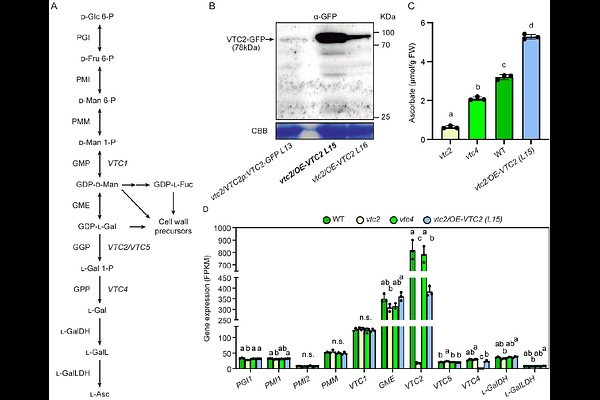Arabidopsis lines with modified ascorbate concentrations reveal a link between ascorbate and auxin biosynthesis

Arabidopsis lines with modified ascorbate concentrations reveal a link between ascorbate and auxin biosynthesis
Fenech, M.; Zulian, V.; Moya-Cuevas, J.; Arnaud, D.; Morilla, I.; Smirnoff, N.; Botella, M. A.; Stepanova, A. N.; Alonso, J. M.; Martin-Pizarro, C.; Amorim-Silva, V.
AbstractAscorbate is the most abundant water-soluble antioxidant in plants, and it is an essential molecule for normal plant development. It is present in all green plants, with very different concentrations in different plant species. While ascorbate accumulation is a trait of nutritional, and therefore, agronomical interest, the impact of different concentrations over cellular homeostasis remains elusive. In order to shed light over this question, we leveraged Arabidopsis lines with very low ascorbate (vtc2 mutant with 20% of WT ascorbate levels), and low ascorbate concentration (vtc4 mutant with 65% of WT levels), and we generated a line that accumulates 165% of WT levels (vtc2/OE-VTC2). An 80% reduction of ascorbate increased the expression of genes implicated in defense against pathogens, but repressed genes associated with abiotic stress responses. Unexpectedly, lines with increased (165% of WT) and decreased (65% of WT) ascorbate levels shared 85% of induced transcription factors and the GO terms associated with their transcriptional programs. Among the group of genes whose expression is positively correlated with ascorbate content, we identified TAA1/WEI8, a gene encoding a tryptophan aminotransferase that catalyzes the first step of auxin biosynthesis. Using a combination of genetic and pharmacological approaches in fluorescent and histochemical reporter lines for auxin biosynthesis and signaling activity, we revealed that TAA1- and TAA1-RELATED2 (TAR2)-mediated auxin biosynthesis is necessary for plants to cope with increased ascorbate concentration in a light-dependent manner, revealing a new layer of complexity in the regulatory landscape of redox homeostasis.